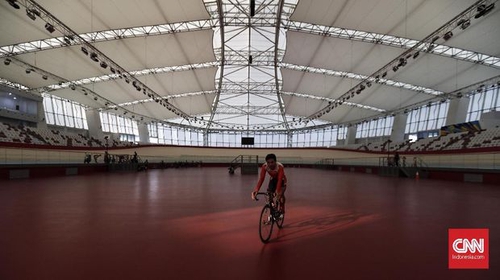
Jakarta International Velodrome (JIV), located in Rawamangun, Jakarta, is claimed to be the best in Southeast Asia and is ready for use at the 2018 Asian Games.
JIV Project Director, Iwan Takwin, said that JIV development takes two years, starting from preparation, construction, to completion. The bicycle racing project with a capacity of up to 5,000 spectators began in 2015.
If VNM is made for the 2017 SEA Games in Kuala Lumpur, the JIV is made for the 2018 Asian Games.
"Compared to Malaysia, our [velodrome] capacity is larger and can reach 3,500 spectators. There [VNM], the capacity of the audience is only 1,000 to 1,500. The building [JIV] is also wider. In Malaysia, velodromenya is closed so always have to use lights, "Iwan told @andravasko recently.
"[Our Velodrome] is more environmentally friendly, we are also more futuristic in terms of design. You could say that in Southeast Asia [JIV] is the best, because the new ones have velodrome Malaysia and Indonesia. In Asia, we can compete like Hong Kong, "he added.
Iwan said that one of the advantages of the velodrome in JIV is the roof of a building that uses a translucent membrane. For two months, he continued, Indonesian cyclists are undergoing a national training camp without using lights.
"If I am not mistaken in Seoul, I also use a membrane roof, this [Seoul Velodrome uses a membrane roof] is known based on the narrative of the South Korean delegation who came here some time ago," Iwan said.
Based on CNNIndonesia.com monitoring, the arena of JIV and its surroundings seems ready to hold the Asian Games in August. Even so, the JIV highlighted parking lots located in open spaces.
In addition to the seating capacity of spectators who are still considered lacking due to land constraints, Iwan acknowledged the capacity of vehicles in parking lots to be one of JIV's shortcomings.
"Actually [the parking area] is sufficient for 275 cars, 100 motorbikes and 10 buses. However, we need to anticipate that routine activities [sports / non-sports] have been running here. Moreover, now the public interest in cycling has increased," Iwan said.
"We expect every week there will be activities here [JIV]. We also have commercial facilities on the ground floor such as cafes or merchandise selling places," he said, calling the construction costs reaching Rp650 billion.
Hundreds of Million Care Costs
Various sports or non-sports activities in JIV are needed to help with maintenance costs that reach hundreds of millions of rupiah.
Iwan conveyed that the high cost of maintenance was mainly derived from the bicycle race track which used Siberian wood. This causes the moisture of the wood to be strictly guarded in Indonesia which has a tropical climate.
"[Maintenance costs] are certainly high, especially in this track, because we have to keep the humidity. That's the main thing. The type of wood is not a tropical characteristic, so the AC must be on. The humidity is 70 percent," said Iwan.
"If the electricity itself is one month, it reaches 250 to 300 million rupiahs, of course it must be supported by the activities held here. We cannot be fixated with just one bicycle race track activity," he said again.
In line with Iwan, Arlan Lukman, director of the venue and environment at INASGOC, confirmed the high cost of maintaining Velodrome. Even so, he feels proud of the Indonesian sports assets.
"Air conditioning machines must be turned on at the velodorme every day so that the humidity of the trajectory is maintained. And the electricity costs can reach 400 million rupiah per month," said Arlan.
"However, this velodrome [JIV] is equivalent to that in London. Indeed, our nation for building facilities is not inferior to other countries, only the maintenance is left for the future," he said again.

Comments